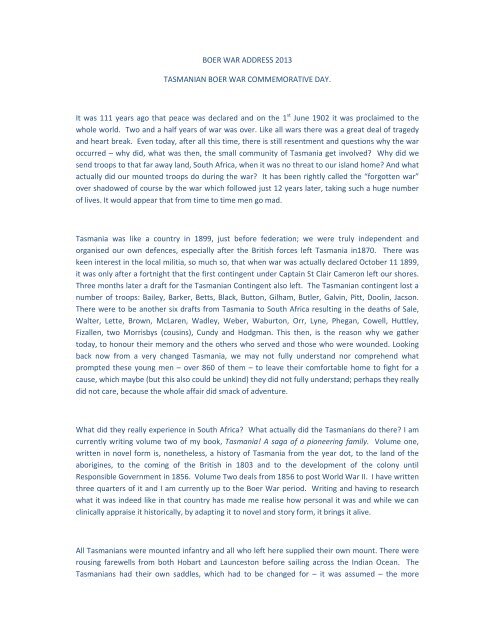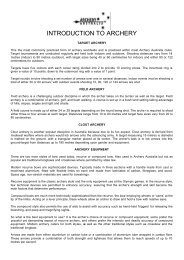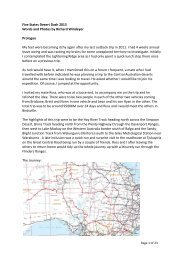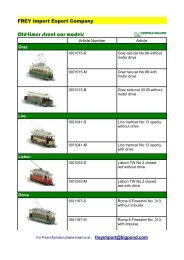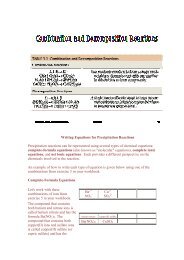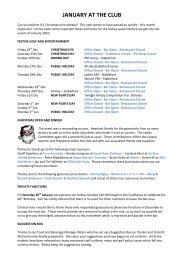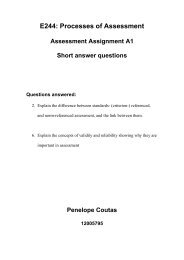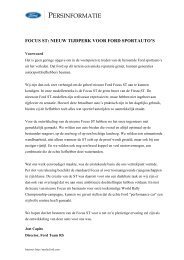available online
available online
available online
You also want an ePaper? Increase the reach of your titles
YUMPU automatically turns print PDFs into web optimized ePapers that Google loves.
BOER WAR ADDRESS 2013<br />
TASMANIAN BOER WAR COMMEMORATIVE DAY.<br />
It was 111 years ago that peace was declared and on the 1 st June 1902 it was proclaimed to the<br />
whole world. Two and a half years of war was over. Like all wars there was a great deal of tragedy<br />
and heart break. Even today, after all this time, there is still resentment and questions why the war<br />
occurred – why did, what was then, the small community of Tasmania get involved? Why did we<br />
send troops to that far away land, South Africa, when it was no threat to our island home? And what<br />
actually did our mounted troops do during the war? It has been rightly called the “forgotten war”<br />
over shadowed of course by the war which followed just 12 years later, taking such a huge number<br />
of lives. It would appear that from time to time men go mad.<br />
Tasmania was like a country in 1899, just before federation; we were truly independent and<br />
organised our own defences, especially after the British forces left Tasmania in1870. There was<br />
keen interest in the local militia, so much so, that when war was actually declared October 11 1899,<br />
it was only after a fortnight that the first contingent under Captain St Clair Cameron left our shores.<br />
Three months later a draft for the Tasmanian Contingent also left. The Tasmanian contingent lost a<br />
number of troops: Bailey, Barker, Betts, Black, Button, Gilham, Butler, Galvin, Pitt, Doolin, Jacson.<br />
There were to be another six drafts from Tasmania to South Africa resulting in the deaths of Sale,<br />
Walter, Lette, Brown, McLaren, Wadley, Weber, Waburton, Orr, Lyne, Phegan, Cowell, Huttley,<br />
Fizallen, two Morrisbys (cousins), Cundy and Hodgman. This then, is the reason why we gather<br />
today, to honour their memory and the others who served and those who were wounded. Looking<br />
back now from a very changed Tasmania, we may not fully understand nor comprehend what<br />
prompted these young men – over 860 of them – to leave their comfortable home to fight for a<br />
cause, which maybe (but this also could be unkind) they did not fully understand; perhaps they really<br />
did not care, because the whole affair did smack of adventure.<br />
What did they really experience in South Africa? What actually did the Tasmanians do there? I am<br />
currently writing volume two of my book, Tasmania! A saga of a pioneering family. Volume one,<br />
written in novel form is, nonetheless, a history of Tasmania from the year dot, to the land of the<br />
aborigines, to the coming of the British in 1803 and to the development of the colony until<br />
Responsible Government in 1856. Volume Two deals from 1856 to post World War II. I have written<br />
three quarters of it and I am currently up to the Boer War period. Writing and having to research<br />
what it was indeed like in that country has made me realise how personal it was and while we can<br />
clinically appraise it historically, by adapting it to novel and story form, it brings it alive.<br />
All Tasmanians were mounted infantry and all who left here supplied their own mount. There were<br />
rousing farewells from both Hobart and Launceston before sailing across the Indian Ocean. The<br />
Tasmanians had their own saddles, which had to be changed for – it was assumed – the more
suitable Australian saddle. The troops upon arrival in Durban were feted by the ladies and welcomed<br />
by the populace, then after a short brief rest they were sent by train to the front. The Tasmanians<br />
loved their horses and Nurse Elizabeth Orr (to whom we unveiled a plaque last year) being a<br />
horsewoman herself, observed how attached all Australians were to their horses. Sadly for a number<br />
of Tasmanians they had to leave their mount behind before being transported to the war zone only<br />
to obtain another when they reached their destination. This was very difficult for them. The job they<br />
were to do was often monotonous and always physically demanding. There were endless patrols,<br />
meaning endless hours in the saddle. They often slept in the open when it was freezing cold and<br />
when it was raining. At dawn they would mount again and take off for the elusive Boers, who were<br />
masters of guerrilla warfare. Enteric fever, better known as typhoid transmitted by contaminated<br />
water, was a constant danger and a number of Tasmanians, Australians and British would die from<br />
the illness; indeed it would be the cause of death of 50 per cent of fatalities. When they confronted<br />
the enemy it was with usually a charge by the Tasmanians often attached to other Australian units or<br />
they were ambushed by the enemy, the Boer. Trooper P.A. Emery of the 2 nd Tasmanian Imperial<br />
Bushmen wrote: “About 60 Boers were seen on a kopje (small hill) this morning, about three miles<br />
from here and 180 passed through two days ago...so we are prepared to give them a good<br />
reception.” Later “...when the troop got within 200 yards of the scrub, the enemy opened fire,<br />
wounding three horses and one man. The other two Tasmanians being cut off”. (end of quote). One<br />
of the Tasmanians, Warburton was killed and Brownell wounded was taken prisoner. It was very<br />
different from conventional warfare; unique. Then there was the burning of homesteads of the<br />
enemy, where the family of the Boers were taken away to the concentration camps. This action was<br />
loathed by the Australians and considered it unworthy of being a soldier. However, one has to admit<br />
there were military reasons for it, but that is another story.<br />
Much more can be said of their action, but the theme of ceremonies of this nature throughout<br />
Australia is the siege of Elands River. It was here, in my humble opinion, where the Australian<br />
soldier was born. At daybreak, 4 th August 1900 250 Australians together with equal number of<br />
Southern Rhodesians and South Africans were attacked and then besieged by 3,000 Boers under the<br />
command of De la Ray. Elands River was a rest camp for the Australians and their allies and the<br />
attack was not anticipated. Nonetheless, the siege went on for a fortnight, with those inside<br />
suffering a casualty rate of 1:3. The horses suffered terribly with 1500 being killed. It was considered<br />
by General Kitchener that the Australians and allies would not survive and it was not until a despatch<br />
got to him that he went to the relief and subsequent release of those besieged. Once asked to<br />
surrender, the word came back to the Boer Commander, “Australians never surrender!” True, there<br />
were but was but two Tasmanians there at the time, they being Troopers Dyer and Hamilton. It was<br />
an amazing effort and – as said – I believe, while not down-playing the massive part Gallipoli played,<br />
the siege of Elands River, was perhaps where the legend of our troops began.<br />
Finally I would like to mention the forthcoming National Reserve Forces Day and Review. This year it<br />
will be held in Launceston, Kings Park, 11am 7 th July with special recognition and thanks to the 16 th<br />
Field Battery for its 152 years history of serving our nation.
Thank you ladies and gentlemen.<br />
BOER WAR COMMEMORATIVE DAY ADDRESS 2012-<br />
HOBART & LAUNCESTON.<br />
Reg. A. Watson<br />
1. Letter from The Governor-General read..-<br />
This year, 2012 is 110 years since Peace was declared. And on this years’ Reserve Forces<br />
Day, Sunday 1 st July the descendants of Boer War servicemen have been asked to march,<br />
leading the parade. After all, those who went to The Anglo-Boer War were all volunteers<br />
and to recognise this important historic fact, the privilege has been extended on that day to<br />
be part of the honour, marching in memory of one’s ancestor. Those here today are invited<br />
to join me and others to march on June 24th. And if you have the commemorative<br />
medallion please wear it on this auspicious occasion. I personally would like to see a good<br />
number of Tasmanians, representing their family who served, to participate on that day. As<br />
said, we will head the march. There is no need to register your participation.<br />
It is important to remember those who served. Often it has been said to me that the war in<br />
South Africa should not have occurred and that Tasmanians and indeed Australians should<br />
not have been involved. War is an evil thing. Many sad and unfortunate things happened in<br />
South Africa all those years ago. So the question must be answered: “why do we hold such<br />
ceremonies as this, which are now held throughout various centres in Australia, as<br />
observances have grown dramatically over the last ten years?”<br />
The motto of the Tasmanian Boer War Commemorative Day is simple; “to honour those<br />
Tasmanians who served”. While I say Tasmanians I am aware that we may have family’s<br />
members who served from other Australian Colonies, British forces and even Boer.<br />
Welcome all; it matters not. Having quoted the motto, I am of the opinion that it would be<br />
ungrateful not to remember those troopers who left Tasmania’s shore, more than 112 years<br />
ago; just fourteen days after war had been declared October 11 1899. I recognise their<br />
readiness and their preparedness to serve their country and a Cause. True, no doubt many<br />
saw it as an opportunity for adventure and that may have been the prime motive.<br />
Nonetheless, if we did not honour their service, in my estimation, that would be ungrateful.<br />
I do not think I could not honour my own grandfather’s service and to ignore it would be<br />
unkind of me. Those men who went away endured all the aspects of modern war; true in
ways a great deal different to the war that followed, The Great War and the only thing<br />
“great” about it was the casualties. But they had the challenge of being shot at, hard patrols,<br />
sickness and disease, lack of sleep, food and separation of their love ones. They served with<br />
distinction and in the vast majority of cases with great honour. At the siege of Elands River,<br />
the Australians held out for a fortnight against overwhelming enemy odds that besieged<br />
them. Called upon to surrender, they replied, “Australians do not surrender”. What a<br />
wonderful cry from those representing a new country. True there were only two Tasmanian<br />
Bushmen at the Elands River siege, they being Sergeant-Major Tom Goucher and Trooper<br />
Edward Phelan; but Tasmania was represented. That is why such a day as this is important –<br />
simply to honour and to recall this ‘forgotten war’. Sadly I have attended Anzac services,<br />
where all the wars that Australia has participated in have been mentioned, but not our<br />
involvement in The Boer War. It has been the aim to highlight this memory to present<br />
generations and hopefully to future ones.<br />
Last Sunday in Hobart I had the pleasure of unveiling a plaque in memory of Nurse Orr, after<br />
the ceremony. You will find on the programme which you may have, a synopsis of her<br />
career, which was simply amazing. This daughter of Tasmania was an incredible person and<br />
the statement contained on the plaque, which stands at the foot of the Hobart Memorial on<br />
the Queen’s Domain is “She lived to serve others”. Devoting her life to help others, it was a<br />
great satisfaction that the memorial to her was eventually unveiled. If an opportunity arises<br />
when you are in Hobart, take a walk up the memorial and inspect the plaque.<br />
Thank –you


